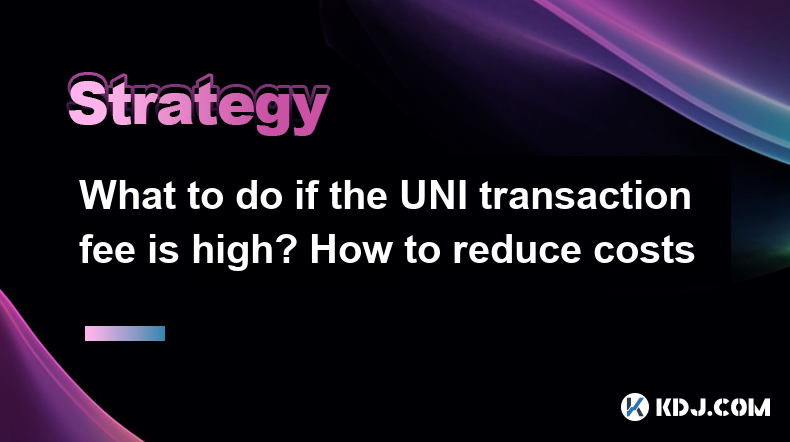-
 bitcoin
bitcoin $121833.232455 USD
-0.63% -
 ethereum
ethereum $4394.437030 USD
-2.00% -
 tether
tether $1.000570 USD
0.04% -
 bnb
bnb $1255.553465 USD
-3.73% -
 xrp
xrp $2.814944 USD
-1.59% -
 solana
solana $221.835346 USD
-2.40% -
 usd-coin
usd-coin $0.999869 USD
0.01% -
 dogecoin
dogecoin $0.249495 USD
-1.32% -
 tron
tron $0.336905 USD
-1.24% -
 cardano
cardano $0.816464 USD
-1.69% -
 chainlink
chainlink $22.130946 USD
-1.27% -
 hyperliquid
hyperliquid $44.208522 USD
-3.46% -
 ethena-usde
ethena-usde $1.000521 USD
0.02% -
 sui
sui $3.422897 USD
-2.51% -
 stellar
stellar $0.380164 USD
-1.31%
What to do if the UNI transaction fee is high? How to reduce costs
High UNI transaction fees on Ethereum are due to network congestion and transaction complexity; use Layer 2 solutions, adjust gas prices, and batch transactions to reduce costs.
May 04, 2025 at 08:03 pm

High transaction fees on the Ethereum network, where Uniswap (UNI) operates, can be a significant concern for users looking to trade or transfer their tokens. Understanding why these fees can be high and learning how to reduce them is crucial for managing your cryptocurrency transactions effectively. In this article, we will explore the reasons behind high UNI transaction fees and provide detailed strategies to help you minimize these costs.
Understanding High UNI Transaction Fees
The primary reason for high UNI transaction fees is the congestion on the Ethereum network. When many users are trying to execute transactions simultaneously, the demand for block space increases, leading to higher fees. Miners prioritize transactions with higher fees, which means users often have to pay more to ensure their transactions are processed quickly.
Another factor contributing to high fees is the complexity of the transaction. For instance, swapping tokens on Uniswap involves multiple steps, such as interacting with smart contracts, which can increase the gas cost. Gas is the unit of measure for the computational effort required to execute operations on the Ethereum network.
Strategies to Reduce UNI Transaction Fees
To effectively manage and reduce your UNI transaction fees, consider the following strategies:
1. Use Layer 2 Solutions
Layer 2 solutions like Optimism and Arbitrum can significantly reduce transaction fees by processing transactions off the main Ethereum chain and then settling them on the mainnet. Here's how you can use these solutions:
- Choose a Layer 2 wallet: Download a wallet that supports Layer 2 transactions, such as MetaMask.
- Bridge your ETH to Layer 2: Use the bridge provided by the Layer 2 solution to transfer your ETH from the Ethereum mainnet to the Layer 2 network.
- Interact with Uniswap on Layer 2: Once your ETH is on the Layer 2 network, you can use Uniswap to swap tokens at a lower cost.
2. Adjust Gas Prices
Adjusting the gas price you're willing to pay can help you find a balance between cost and transaction speed. Here's how to do it:
- Use a gas tracker: Websites like EthGasStation or GasNow provide real-time data on gas prices. Monitor these to find the optimal time to execute your transaction.
- Set a custom gas price: In your wallet, such as MetaMask, you can set a custom gas price. Lowering the gas price can reduce your fees, but it may take longer for your transaction to be processed.
3. Use Gasless Transactions
Some platforms offer gasless transactions, where the platform pays the gas fee on your behalf. For example, platforms like 1inch and Matcha allow you to swap tokens without paying gas directly. Here's how to use these services:
- Visit the platform's website: Go to the website of the gasless transaction platform.
- Connect your wallet: Link your Ethereum wallet to the platform.
- Execute your swap: Follow the platform's instructions to swap your tokens. The platform will handle the gas fees.
4. Batch Transactions
Batching multiple transactions into a single transaction can reduce the overall gas cost. This is particularly useful if you need to perform multiple swaps or transfers. Here's how to batch transactions:
- Use a wallet that supports batching: Wallets like Gnosis Safe allow you to batch multiple transactions.
- Prepare your transactions: List out all the transactions you want to batch.
- Execute the batch: Use the wallet's interface to execute all transactions in one go, reducing the total gas cost.
5. Use DeFi Aggregators
DeFi aggregators like 1inch and ParaSwap can help you find the best routes for your swaps, potentially reducing fees. Here's how to use them:
- Visit the aggregator's website: Go to the website of the DeFi aggregator.
- Connect your wallet: Link your Ethereum wallet to the platform.
- Enter your swap details: Specify the tokens you want to swap and the amount.
- Execute the swap: The aggregator will find the most cost-effective route for your swap and execute it.
Monitoring and Timing Your Transactions
Monitoring the Ethereum network's congestion and timing your transactions can also help you reduce fees. Here's how to do it:
- Use blockchain explorers: Websites like Etherscan provide real-time data on network congestion. Look for periods of low activity to execute your transactions.
- Schedule your transactions: Some wallets allow you to schedule transactions for a later time. Use this feature to execute your transactions during off-peak hours.
Conclusion
By understanding the factors that contribute to high UNI transaction fees and implementing the strategies outlined above, you can effectively manage and reduce your costs. Whether you choose to use Layer 2 solutions, adjust gas prices, utilize gasless transactions, batch your transactions, or leverage DeFi aggregators, there are multiple ways to minimize your expenses on the Ethereum network.
Frequently Asked Questions
Q: Can I use a different blockchain to avoid high UNI transaction fees?A: Yes, you can use decentralized exchanges on other blockchains like Binance Smart Chain or Polygon, which typically have lower transaction fees. However, you would need to bridge your UNI tokens to these networks, which may involve additional steps and potential risks.
Q: Are there any risks associated with using Layer 2 solutions?A: While Layer 2 solutions can significantly reduce fees, they come with their own set of risks, such as potential security vulnerabilities and the need to bridge your assets back to the mainnet. Always research and understand the risks before using any Layer 2 solution.
Q: How can I estimate the gas cost before executing a transaction?A: You can use tools like EthGasStation or the gas estimator in wallets like MetaMask to get an estimate of the gas cost before executing your transaction. These tools provide real-time data on gas prices and can help you plan your transactions more effectively.
Q: Is it possible to cancel a transaction if the gas fee is too high?A: Yes, if you've set a high gas fee and want to cancel the transaction, you can do so by sending a new transaction with the same nonce but a higher gas price to replace the original transaction. This process is known as a 'speed-up' or 'cancel' transaction, and it can be done through wallets like MetaMask.
Disclaimer:info@kdj.com
The information provided is not trading advice. kdj.com does not assume any responsibility for any investments made based on the information provided in this article. Cryptocurrencies are highly volatile and it is highly recommended that you invest with caution after thorough research!
If you believe that the content used on this website infringes your copyright, please contact us immediately (info@kdj.com) and we will delete it promptly.
- Bitcoin, Trump, and Trade Wars: Retaliation Rattles the Crypto Market
- 2025-10-11 08:25:15
- Global Banks, G7 Stablecoins, and Exploration: Charting the Future of Finance
- 2025-10-11 08:25:15
- Morgan Stanley, Crypto, and the Gates of Mainstream Adoption
- 2025-10-11 08:30:01
- Donald Trump, Tariffs, and Signaling Back: A New Era of Trade Wars?
- 2025-10-11 08:30:01
- Navigating the Crypto Tide: From Fading Wallet Tokens to the Rise of LivLive and BNB Memecoins in '25
- 2025-10-11 08:30:01
- Roughrider Coin: Fiserv and North Dakota's Bold Stablecoin Leap
- 2025-10-11 08:30:16
Related knowledge

Practical parameter settings for a Bitcoin multi-timeframe moving average system
Sep 18,2025 at 10:54pm
Optimizing Timeframe Combinations for Bitcoin Trading1. Selecting appropriate timeframes is crucial when building a multi-timeframe moving average sys...

How can I filter out false breakouts in Dogecoin high-frequency trading?
Sep 22,2025 at 01:00am
Understanding False Breakouts in Dogecoin Trading1. A false breakout occurs when Dogecoin's price appears to move beyond a defined support or resistan...

Techniques for identifying tops and bottoms in the Bitcoin on-chain NVT model
Sep 20,2025 at 07:54pm
Understanding the NVT Model in Bitcoin Analysis1. The Network Value to Transactions (NVT) ratio is often described as the 'P/E ratio' of the cryptocur...

What does the surge in open interest in Bitcoincoin futures mean?
Sep 20,2025 at 11:18pm
Understanding the Surge in Dogecoin Futures Open Interest1. A surge in open interest within Dogecoin futures indicates a growing number of active cont...

How can I use the Ethereum USDT premium to gauge market sentiment?
Sep 18,2025 at 11:55pm
Understanding the Ethereum USDT Premium1. The Ethereum USDT premium refers to the price difference between USDT (Tether) traded on Ethereum-based plat...

What should I do if Ethereum staking yields decline?
Sep 20,2025 at 06:18am
Understanding the Causes Behind Declining Ethereum Staking Yields1. The Ethereum network transitioned to a proof-of-stake consensus mechanism with the...

Practical parameter settings for a Bitcoin multi-timeframe moving average system
Sep 18,2025 at 10:54pm
Optimizing Timeframe Combinations for Bitcoin Trading1. Selecting appropriate timeframes is crucial when building a multi-timeframe moving average sys...

How can I filter out false breakouts in Dogecoin high-frequency trading?
Sep 22,2025 at 01:00am
Understanding False Breakouts in Dogecoin Trading1. A false breakout occurs when Dogecoin's price appears to move beyond a defined support or resistan...

Techniques for identifying tops and bottoms in the Bitcoin on-chain NVT model
Sep 20,2025 at 07:54pm
Understanding the NVT Model in Bitcoin Analysis1. The Network Value to Transactions (NVT) ratio is often described as the 'P/E ratio' of the cryptocur...

What does the surge in open interest in Bitcoincoin futures mean?
Sep 20,2025 at 11:18pm
Understanding the Surge in Dogecoin Futures Open Interest1. A surge in open interest within Dogecoin futures indicates a growing number of active cont...

How can I use the Ethereum USDT premium to gauge market sentiment?
Sep 18,2025 at 11:55pm
Understanding the Ethereum USDT Premium1. The Ethereum USDT premium refers to the price difference between USDT (Tether) traded on Ethereum-based plat...

What should I do if Ethereum staking yields decline?
Sep 20,2025 at 06:18am
Understanding the Causes Behind Declining Ethereum Staking Yields1. The Ethereum network transitioned to a proof-of-stake consensus mechanism with the...
See all articles










































































